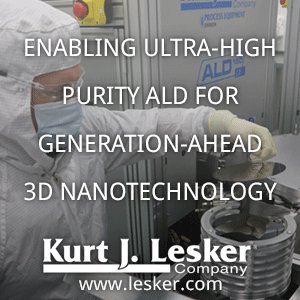Large-area (~9 cm) mono-, bi-, and tri-layer MoS2 on a SiO2 substrate comparable in size to a cellular phone display screen. (Picture From: Self-Limiting Layer Synthesis of Transition Metal Dichalcogenides, licensed under a Creative Commons Attribution 4.0 International License.)
As you all know ALD is a self-limiting growth method,however in this case where growth occurs by the formation of multi-layer islands it is difficult to achieve the layer controllability needed when compared to CVD. That is why the research team states three important findings for ALD growth of 2D layer structured materials:
- Maximizing the self-limiting behavior of the ALD process to achieve layer controllability needed for a 2D structure by careful optimization of the process conditions (e.g., temperature, pressure, exposure of precursor/reactant)
- Careful selection of the precursor and reactant - in this study MoCl5 and H2S are used as the precursors.
- Understand the surface characteristics of the material being deposited.
Read all about it in the excellent open source report in published early this year in Scientific Reports:
Self-Limiting Layer Synthesis of Transition Metal Dichalcogenides
Youngjun Kim, Jeong-Gyu Song, Yong Ju Park, Gyeong Hee Ryu, Su Jeong Lee, Jin Sung Kim, Pyo Jin Jeon, Chang Wan Lee, Whang Je Woo, Taejin Choi, Hanearl Jung, Han-Bo-Ram Lee, Jae-Min Myoung, Seongil Im, Zonghoon Lee, Jong-Hyun Ahn, Jusang Park& Hyungjun Kim
Scientific Reports 6, Article number: 18754 (2016), doi:10.1038/srep18754
This work reports the self-limiting synthesis of an atomically thin, two dimensional transition metal dichalcogenides (2D TMDCs) in the form of MoS2. The layer controllability and large area uniformity essential for electronic and optical device applications is achieved through atomic layer deposition in what is named self-limiting layer synthesis (SLS); a process in which the number of layers is determined by temperature rather than process cycles due to the chemically inactive nature of 2D MoS2. Through spectroscopic and microscopic investigation it is demonstrated that SLS is capable of producing MoS2 with a wafer-scale (~10 cm) layer-number uniformity of more than 90%, which when used as the active layer in a top-gated field-effect transistor, produces an on/off ratio as high as 108. This process is also shown to be applicable to WSe2, with a PN diode fabricated from a MoS2/WSe2 heterostructure exhibiting gate-tunable rectifying characteristics.
Scientific Reports 6, Article number: 18754 (2016), doi:10.1038/srep18754
This work reports the self-limiting synthesis of an atomically thin, two dimensional transition metal dichalcogenides (2D TMDCs) in the form of MoS2. The layer controllability and large area uniformity essential for electronic and optical device applications is achieved through atomic layer deposition in what is named self-limiting layer synthesis (SLS); a process in which the number of layers is determined by temperature rather than process cycles due to the chemically inactive nature of 2D MoS2. Through spectroscopic and microscopic investigation it is demonstrated that SLS is capable of producing MoS2 with a wafer-scale (~10 cm) layer-number uniformity of more than 90%, which when used as the active layer in a top-gated field-effect transistor, produces an on/off ratio as high as 108. This process is also shown to be applicable to WSe2, with a PN diode fabricated from a MoS2/WSe2 heterostructure exhibiting gate-tunable rectifying characteristics.



%20(1).png)

No comments:
Post a Comment